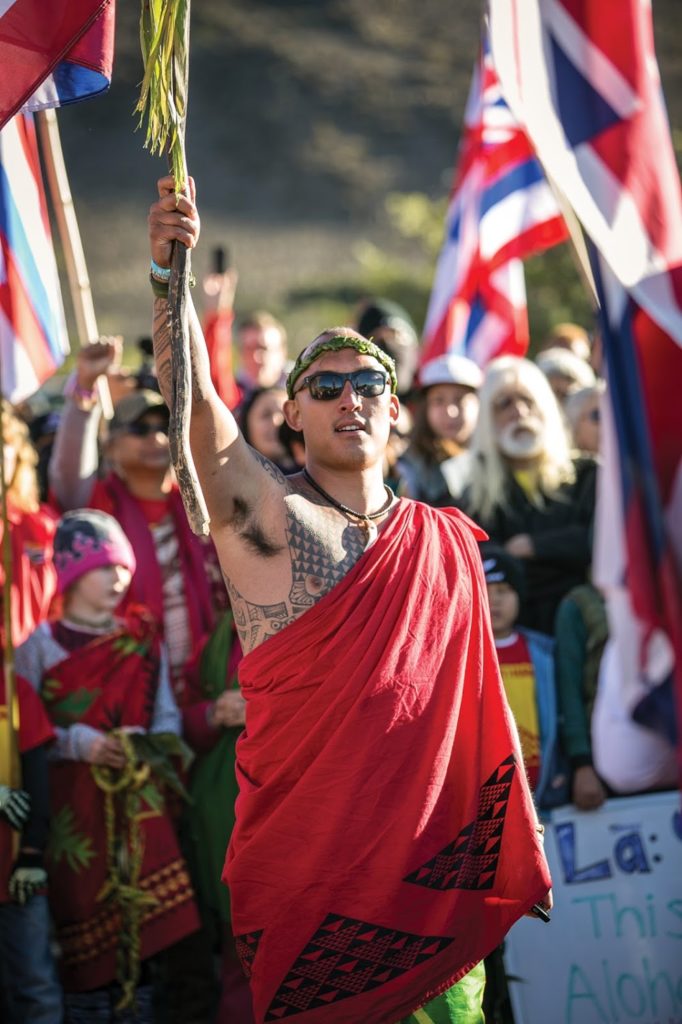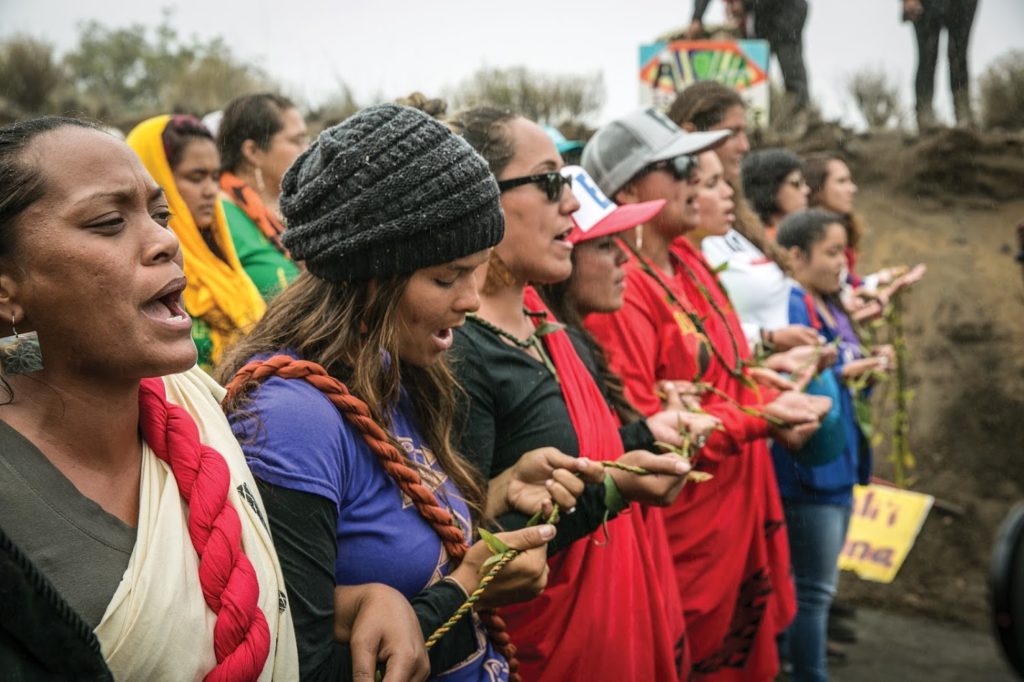The Rise of a New, Global, Indigenous Left
INDIGENOUS RIGHTS, HUMAN RIGHTS, ACTIVISM, ASIA--PACIFIC, 9 Jul 2018
Ikaika Hussey, Will Caron and Ed Lane | Summit Magazine - TRANSCEND Media Service
Indigenous peoples have, by definition, been around for a long time. But a new generation of connected campaigners has arisen, using technology to apply timeless wisdom to modern problems.

Indigenous Hawaiian water protectors hold space on Mauna Kea and sing Kumu Hina Wong Kalu’s inspirational song “Kū Ha‘aheo” as law enforcement officers arrive at the scene to attempt to break their blockade. | Te Rawhitiroa Bosch
Mauna Kea rises 13,803 feet from the sea floor, towering high above the flank of Hawai‘i Island. The road up the mountain snakes with switchbacks. Normally, the air is clear and dry. But on a June morning in 2015, the mountain is shrouded in mist and fog. Dew adorns the hair of the thousands gathered there who stand in lālani, in rows, waiting for the caravan of construction workers to arrive and attempt to begin grading and grubbing the land to make way for the Thirty Meter Telescope.
“Kū ha‘aheo e ku‘u Hawai‘i…”
The first row comprises keiki and kūpuna—children and elders—at Hale Pōhaku, near the traditional structure that serves as the primary meeting spot for the protectors. One row is for wāhine (women) warriors; another for hula dancers.
At daybreak the first trucks begin moving up the mountain. They move slowly along the road toward the summit, but they are slowed by the checkpoints set up by protectors who place their bodies in between the vehicles and the mountain’s summit. At Pu‘u Huluhulu they are hindered, and again at Hale Pōhaku.
“Ka māmakakaua…”
Enforcement officers from the Department of Land and Natural Resources (DLNR), a special branch of the State of Hawai‘i executive government charged with protecting conservation areas like Mauna Kea, are visibly conflicted about their role on the mountain that day. Their job, after all, is the enforcement of conservation district rules, which seem to preclude building a massive industrial structure on its apex.
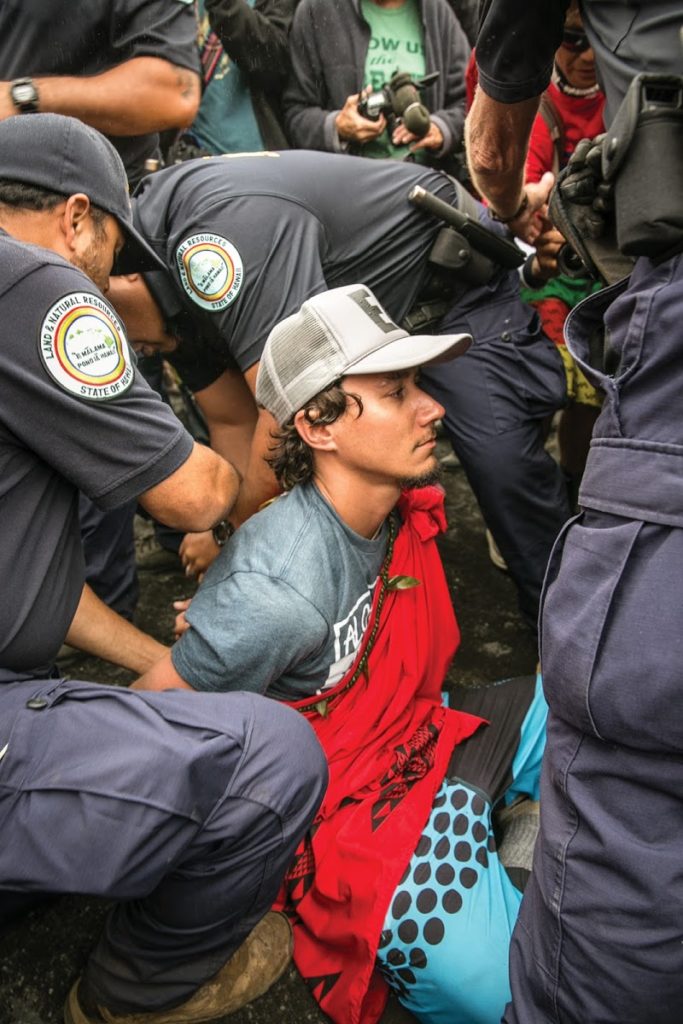
Kaho‘okahi Kanuha was among dozens arrested on the slopes of Mauna Kea. In his court defense he chanted his genealogy going back 17 generations to the time of ‘Umi-a-Liloa, a storied chief of Hawai‘i Island. Kanuha then shared a story of ‘Umi preventing the desecration of lands including Mauna Kea, Mauna Loa and Hualalai. | Te Rawhitiroa Bosch
At the third stop, DLNR officers finally begin to make arrests. Among the bevy of Hawaiians whose wrists are zip-tied as they sit still on the dirt and gravel road, refusing to move of their own volition, are University of Hawai‘i Maui Community College professor and activist Kaleikoa Ka‘eo and then-26-year-old community organizer Kaho‘okahi Kanuha, who was among the first of the wave of millennial protectors that had used social media to rally the cause and who formed the backbone of the effort to shut down the telescope project.
Some DLNR officers are Hawaiian themselves, and a few weep as they haul their extended family members off the path. All the while, floating through the intermittent mist, is the constant refrain of Kumu Hina Wong-Kalu’s song, “Kū Ha‘aheo.”
Kū ha‘aheo e ku‘u Hawai‘i
Stand tall my Hawai‘iMāmakakaua o ku‘u ‘āina
Band of warriors of my land‘O ke ‘ehu kakahiaka o nā ‘ōiwi o Hawai‘i nei
The new dawn for our people of Hawai‘i is upon usNo ku‘u lāhui e hā‘awi pau a i ola mau
For my nation I give my all so that our legacy lives on
By 3 p.m., the trucks and police are still quite a distance from the summit when their slow procession is brought to a complete halt. Boulders have moved into the road (it was unclear, and remains unclear, whether the boulders had been purposefully moved or simply appeared). A DLNR officer alights from his vehicle and, as the mist clears, he sees all of the pōhaku in the road. He yells an epithet—it is already high afternoon, and work on the mountain must be completed by 6 p.m. so construction workers can descend the summit before freezing night falls. Another day of construction has been lost. The officers turn around and descend the mountain; the protectors have won the day.
Mauna Kea is a mountain, but the struggle it represents is not an island unto itself. Mauna Kea has become a gathering place that beckons to a new generation of activists: protectors, not protesters, with an ethos of kapu aloha—what Mohandas Gandhi might call satyagraha or what Dr. Martin Luther King Jr. would describe as unyielding love for one another. With a political consciousness that is grounded in indigenous worldviews, a connection to the global community via the most modern of communication technologies, and an urgent cause taken up in a time when the ecological balance of the entire planet is so precarious, the elements they fight for—water, land, spirit—are key to our survival as a species.
Malia Hulleman, a native Hawaiian from O‘ahu’s windward coast, was at Mauna Kea, and she took these experiences and lessons with her when she packed her bags and headed to the Standing Rock Indian Reservation.
“I wanted to see our culture perpetuated,” she says about her decision to fly to Bismarck, North Dakota and drive south to the Oceti Sakowin Camp where indigenous people from across the continental United States, and beyond, were gathering to resist the construction of the Dakota Access Pipeline (DAPL), a transnational oil line that proposes to transport Canadian tar sand oil across the United States. “It breaks my heart to see how depressed the indigenous culture is on O‘ahu; how complacent we have become in destroying our ‘āina. There is not a lot of land—we all live in the city. Our situation mirrors what has happened to Native Americans on their land. That is why I went.”
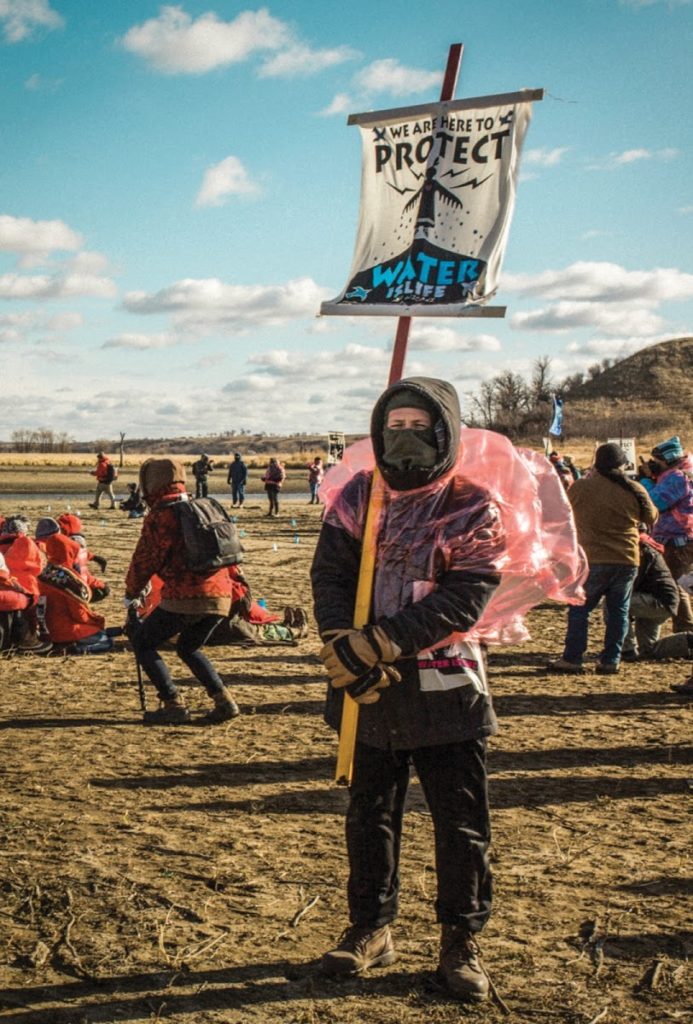
A group of water protectors hold space during a ceremony to bring awareness about Red Fawn, who was accused of shooting at officers during a raid on October 27, 2016 near the Dakota Access Pipeline. Cannonball, ND. | Josué Rivas
Assembling Alliances
“We’ve made so many connections; this feeling of solidarity comes to me very naturally,” says Hāwane Rios, a young Hawaiian activist and musician who stood—both at Mauna Kea and at Standing Rock—for indigenous self-determination, human rights and the preservation of our most precious resource: water. “There’s an unspoken promise, now, to back each other up: Through prayers, through media, through singing about it, through everything we do because when we say we are born from these lands, that is the same; our love for the land is the same.”
“One of the main things we saw coming out of the Mauna Kea struggle was the use of nonviolent direct action,” says Krystal Two Bulls, an activist with roots in the Oglala Lakota and Northern Cheyenne nations. “We saw Hawaiians using soft blockades on Mauna Kea and we saw how effective they were. It was significant in shaping our efforts at Standing Rock. We knew that nonviolent direct action had to be one of the main tactics that we would deploy; in fact, we knew that our strategy had to center around it the same way it did on Mauna Kea.”
Two Bulls was at an Indigenous Peoples conference at the exact time that the first wave of arrests on Mauna Kea began. At this conference, she met Hawaiian activist Kealoha Pisciotta. “I remember talking with her at length about the struggle on the mountain,” recalls Two Bulls. “The discussion was highly emotional because it was hard for Kealoha to be away from her people during a time when she felt she was needed back home.”
The conversations that Two Bulls and Pisciotta had together are indicative of conversations indigenous people around the world are beginning to have with one another about resistance, survival and self-determination. And out of these conversations, a strong sense of solidarity has arisen between indigenous peoples that has been carried forward to struggles like Standing Rock.
“There are so many fights going on simultaneously, at this moment, everywhere, that I can’t even come close to naming all of them,” says Two Bulls. “And with the Trump Administration, we’re anticipating that the resistance will grow that much stronger. We have to build a solid platform for us all to stand on together.”
Mauna Kea; Palestine; the struggle of the Tohono O’odham down at the Mexican border (who are preparing to resist any efforts to build Mr. Trump’s proposed wall through their land); struggles against the Trans-Pecos Pipeline, the Plains Pipeline in Oklahoma, the Sabal Trail Pipeline in Florida; struggles against the construction of new refineries being proposed near Philadelphia; and the struggle against brutal environmental racism at Oak Flat—these are just a few examples of indigenous struggles that Two Bulls is actively connecting to her own.
“The San Carlos Apache at Oak Flat, Arizona—the reservation land that the U.S. government put them on is surrounded all the way ‘round by three giant copper mines. Their water is contaminated and their people are dying of cancer,” says Two Bulls. “When we’re talking about water anywhere around the world, most likely it’s indigenous people that are being exploited. So I think indigenous peoples have to be at the forefront of the movement to protect water around the world, and we need to be prepared.”

Water protectors hold a prayer on the banks of the Missouri River while Bismarck Police spray them with gas.
Cannonball, ND. | Josué Rivas
Two Bulls envisions a vehicle for training indigenous people in nonviolent direct action—rooted in the recognition of the sacred, interwoven with prayer and ceremony. “Because that is one of the main things that separates indigenous protectors from the corporations and people that are pushing for development, extreme extraction and exploitative capitalism,” she says.
“As a movement, our campaign, our strategy and even our tactics have to be decisive, so our decision-making structure needs to be established and consistent. That’s not something that you can determine in the middle of a campaign: It’ll be too late and you’ll lose focus,” says Two Bulls. “There’s no room for ego, either. That will destroy your movement before it gets anywhere. Both Andre Perez and Kaho‘okahi were instrumental on the mountain, and in our struggle as well in accelerating our learning curve.”
Along with Hawaiian activists such as Perez, Rios, Pua Case and others, Dr. Kalamaoka‘aina Niheu, a co-founder of the Standing Rock Medical Council, helped to coordinate training and logistics of the organizational effort at Standing Rock. Niheu is familiar with the unique aspects of sustaining a month-long campaign through bitter cold, police brutality and inhumane tactics, while forging a sense of purpose that could serve as lodestar for future battles.
“Part of what made Standing Rock difficult was the constant swelling and receding of numbers—sometimes there were as many as 7,000 people there that all needed tents, access to toilets and medical care,” Niheu says. “But the full effort actually involved hundreds of thousands of people, offering support and sending supplies and donations.”
Niheu says that the way in which the camp functioned through the long months of resistance speaks to the depth of cooperation, from basic logistics to the welcoming of the U.S. military veterans who came to help. She also recognizes that the toll on the community was high, and that the racism and brutality the protectors encountered has led to very real cases of Post-Traumatic Stress Disorder.
“The sustained commitment has an added strain,” she says. “But, on the other hand, a community this small hosting so many people for so long is inspirational.”
“Nonviolent direct action has always been there in our indigenous communities, even if it’s not always called that,” explains Two Bulls. “We simply resist because that is what our stories and teachings tell us: how we are supposed to be in relation to the land. All we are trying to do is maintain that and uphold those teachings. Sometimes that equates to civil disobedience, but that’s not how we define it. We define it as simply being stewards of the land; or trying to protect a way of life; or trying to uphold a teaching that has been handed down for generations, from time immemorial.
“Water is everything; there’s no life without water,” she continues. “In Cheyenne, we don’t have a direct equivalent to Mni Wiconi, or Water is Life. Our version of that translates to Water is Living. Yes, water is life, but to us it is also a living thing. It has a life of its own.”

Young, indigenous activists Kuʻuipo Freitas (left) and Pono Kuikahi (right) form a hand gesture symbolic of the struggle on Mauna Kea. Freitas started Mauna Media, a digital video documentation service that shared, with a global audience, the story of the months-long blockade. The hand gesture the pair are making became a global sign of solidarity broadcast across social media platforms under the hashtag #WeAreMaunaKea.
| Te Rawhitiroa Bosch
A World Smaller Than Ever
The conflict at Standing Rock was set against a backdrop of global climate change in which the actions of rapacious transnational corporations continue to make fresh water scarcer and threaten to ignite civil unrest on a far grander scale than we have seen, possibly ever. The stakes represented by the movements at Standing Rock and Mauna Kea could not be higher. And the media messaging, digital engagement and rapid mobilization techniques that young protectors have pioneered are crucial blueprints for other movements around the world.
“One thing that Standing Rock had that changed the game was social media,” says Two Bulls. “Technology has helped movements around the world to unite under one banner; to realize that it’s the same story, just different locations. And we’ve never had access to that before. It was a major game changer and it will continue to be moving forward.”
From the life-giving waterways of the Mekong Delta that empty into the South China Sea to the mighty Brahmaputra River headwaters at the roof of the world, indigenous, grassroots groups protecting water rights in Asia are mobilizing as well. Finding a voice and a platform through social media and other online tools has helped. But sustained organization that combines local knowledge with sophisticated logistics is a rarity. People come and go. Networks frazzle as individuals succumb to quotidian financial realities.
In Vietnam, activist Thuat Nguyen Huynh has organized community engagement to protect the Dong Nai River and Cat Tien National Park. The Mekong River faces great peril from riparian issues including massive multilateral lending for government-supported dam projects, pollution from fertilizer runoff and salinity encroachment as the seas rise from global warming. The river is an artery of life that provides sustenance and economic activity for hundreds of millions and, although information streams are growing, regional talks and grassroots efforts are still far short of the sophistication seen in the Standing Rock mobilization.
Community meetings are being held with local officials, but a widespread civil protest campaign is unlikely for domestic political reasons and practicality. “We need to sit and talk and plan, but we also need to work,” Nguyen says. “The resources to manage full-time are just not there and it is hard to see where they would come from.”
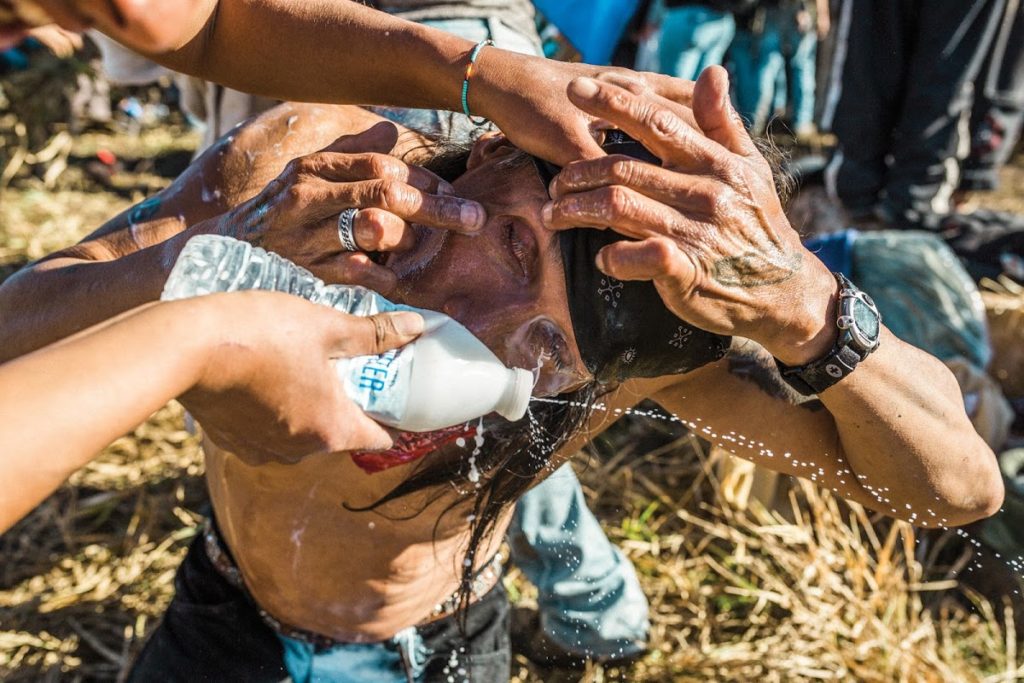
A water protector receives medical aid after being maced by police during a ceremony at Standing Rock. The brutality shown by law enforcement against indigenous peoples struggling against government-backed, corporate exploitation of land and resources is not limited to Cannonball, ND, however. | Josué Rivas
Jefferson Fox is a Senior Fellow at the East-West Center in Honolulu who follows land-use and land-cover change in Asia, and its impact on the region and the global environment.
“In Southeast Asia, I think community groups have access to a surprising amount of information,” he says, citing an online data compilation effort on the Mekong region. “The website opendevelopmentmekong.net publishes a lot of information on water resources, development plans, land use and governance for all the countries in the region. One constraint, however, for community groups is that the data is mostly compiled in English, limiting many users. But the numerous environmental NGOs in the region are quite conversant in English.”
But activists will point out that information does not always immediately lead to power and, in Vietnam, that is particularly the case. The government controls the press and offers little space for community voices to be heard in big development plans. However, regional variations are cracking the paradigms of government control and capitalist development. Fledgling activist groups are watching Myanmar with great interest as the Myitsome Dam project in Kachin State is being shut down, in part, through community opposition that has latched onto and successfully targeted natural economic pressure points.
Indigenous community groups fighting for access to clean water in Asia face a host of issues from deforestation to an explosion of small scale mining concessions, from land-grabbing to the spread of industrial agriculture and the increasing use of dangerous pesticides.
Water rights struggles around the world, with rare exception, see companies and governments as the winners, holding the political, technical, legal and expert resources firmly in one hand as they crack the whip with the other and make fresh water more scarce. This happens through massive dams that threaten riparian systems that can be centuries or even millennia old, or via industrial-scale diversions and unchecked pollution that, when added with climate change, portend environmental and social calamity sooner rather than later.
Standing Rock and Mauna Kea, then, each stand out for the tactical deployment of social media, combined with highly organized on-the-ground activism supported by allies who see a kismet in purpose. What has gone on at Standing Rock is worth noting because, in the United States and just as acutely abroad, forces are gathering that aim to take social progress back to the days when African-Americans were brutalized by southern police departments for resisting racist policies like segregation.
The results of these struggles for land, water, identity and cultural longevity clearly show that light and air do not always win the day, as they do in Disney’s Star Wars reboots. Technology and water rights are deeply connected now with a sense of cautious wonderment at what could be possible to better steward this precious resource, from conservation and engineering marvels to the much darker picture of civil groups fighting for their very lives.

A gesture of resistance from water protectors as they are sprayed with high-power water cannons during a confrontation on November 20, 2016 in Cannonball, ND. | Josué Rivas
Fire and Water
Within days of being sworn into office, President Donald Trump ordered the Army Corps of Engineers to fast-track the permit process for the Dakota Access Pipeline project, ignoring environmental review mechanisms and utterly solidifying the federal stance that indigenous rights, culture and knowledge are insignificant before the onslaught of Western wealth extraction. The eviction notice was sent to the camps at Standing Rock and, within 48 hours, the protectors were forcibly removed by a militarized police force. Before they withdrew, however, the protectors set their remaining tents, tipis and yurts ablaze.
An Esquire magazine headline from the following day read, “The Standing Rock Fire Is Visible All Over the United States.” In actuality, it was visible far beyond the borders of America—a visceral representation of the fire that protectors in Hawai‘i and North Dakota have already lit within the hearts and minds of indigenous people and their allies around the world.
“The camps may have been raided but we haven’t stopped fighting,” says Two Bulls. “There are still people on the ground trying to get the Sacred Stone Camp back up and running. That was their home and it is still is.”
The indigenous coalition that Two Bulls is a part of is rolling out a new divestment campaign in partnership with Lakota activist Matt Remle of Seattle, who helped lead his city to divest more than $3 billion from Wells Fargo over the DAPL project. They’ve created a toolkit for other people to replicate divestment campaigns in their own communities, in unions, educational institutions and in other larger organizations. The coalition is comprised of multiple organizations, including the Boycott, Divestment and Sanctions campaign that emerged out of the Palestinian struggle against Israeli occupation. And each organization has its own, widespread audience so, by partnering, these groups are multiplying the scope of reach of the narrative of indigenous struggle exponentially.
“These narratives are based on opposition to forces operating at the behest of the government and big oil, and they will succeed only through people power,” says Niheu.
“There’s much more work that needs to be done for indigenous communities,” she adds. “Even after we win, the results will need to be sustained, and both Standing Rock and Mauna Kea conjure history and reflect the present. The real results, however, will only be seen much further down the road.”
“Our people traversed across the ocean for thousands of years, and connected with peoples wherever they went. We are connecting in the same way,” says Rios. “There’s an old connection, an old memory that surfaces, and I think we’re all remembering now how to bring people together, and not be divided by history, color or race. We’re all made of the same thing. We’re letting go of all things in society that are telling us that we’re separate.
“Everyone is on a search to connect and to find their creation stories, their grounding,” she continues. “They’re trying to find their mountains; trying to find their rivers. This is an opportunity for a widespread healing. We all have to recognize our privileges, and understand what society has done to us, but this is a chance to heal.”

Department of Land and Natural Resources officers approach the soft blockade Mauna Kea protectors put up in preparation to make arrests. | Te Rawhitiroa Bosch
_____________________________________________
Art by Te Rawhitiroa Bosch and Josué Rivas
Go to Original – summitzine.com
DISCLAIMER: The statements, views and opinions expressed in pieces republished here are solely those of the authors and do not necessarily represent those of TMS. In accordance with title 17 U.S.C. section 107, this material is distributed without profit to those who have expressed a prior interest in receiving the included information for research and educational purposes. TMS has no affiliation whatsoever with the originator of this article nor is TMS endorsed or sponsored by the originator. “GO TO ORIGINAL” links are provided as a convenience to our readers and allow for verification of authenticity. However, as originating pages are often updated by their originating host sites, the versions posted may not match the versions our readers view when clicking the “GO TO ORIGINAL” links. This site contains copyrighted material the use of which has not always been specifically authorized by the copyright owner. We are making such material available in our efforts to advance understanding of environmental, political, human rights, economic, democracy, scientific, and social justice issues, etc. We believe this constitutes a ‘fair use’ of any such copyrighted material as provided for in section 107 of the US Copyright Law. In accordance with Title 17 U.S.C. Section 107, the material on this site is distributed without profit to those who have expressed a prior interest in receiving the included information for research and educational purposes. For more information go to: http://www.law.cornell.edu/uscode/17/107.shtml. If you wish to use copyrighted material from this site for purposes of your own that go beyond ‘fair use’, you must obtain permission from the copyright owner.
Read more
Click here to go to the current weekly digest or pick another article:
INDIGENOUS RIGHTS:
- We Must Purge Genocide from the Marrow of Our Bones
- The Day of the World’s Indigenous Peoples
- ‘A World without Borders’: Revolutionary Love and Solidarity for Palestine
HUMAN RIGHTS:
- How the Human Rights Industry Manufactures Consent for “Regime Change”
- Genocide Emergency: Gaza and the West Bank 2024
- ‘We Will Leave When the Last Palestinian Leaves’: The Defiant Last Stand of the Doctors of Kamal Adwan Hospital
ACTIVISM:
- CODEPINK Responds to US Senate McCarthy-Style Attack
- Act Now against These Companies Profiting from the Genocide of the Palestinian People
- Conscientious Objectors Refuse to Enlist in the Israeli Army: “Get Out of Gaza Now!”
ASIA--PACIFIC:
